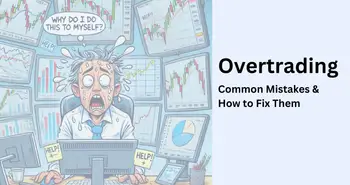Trading versus Investing

As an expert in the field, I am often asked about the key differences between trading and investing. While both strategies involve the buying and selling of financial assets, there are distinct characteristics and approaches that set them apart. In this article, I will delve into the basics of trading and investing, explore their key characteristics, discuss the risks and rewards associated with each, and provide guidance on how to choose the right strategy for your financial goals.
Understanding the Basics of Trading and Investing
Defining Trading: A Brief Overview
Trading is the process of buying and selling financial instruments, such as stocks, bonds, commodities, or currencies, with the aim of profiting from short-term price fluctuations. Traders actively participate in the market, utilizing technical analysis, fundamental analysis, or a combination of both, to identify opportunities and execute trades swiftly.
One key aspect of trading is the concept of risk management. Traders often employ various strategies to mitigate risks, such as setting stop-loss orders to limit potential losses or diversifying their portfolios to spread risk across different assets. Additionally, traders need to stay informed about market trends, economic indicators, and geopolitical events that can impact the prices of the assets they trade.
Defining Investing: A Brief Overview
Investing, on the other hand, involves buying financial assets with the intention of holding them for an extended period. Investors take a long-term perspective, focusing on the fundamental value and growth potential of the assets. They aim to generate wealth over time through a combination of capital appreciation and income from dividends.
Successful investors often follow a disciplined approach to investing, sticking to a well-defined investment strategy and avoiding emotional decision-making. They conduct thorough research on the companies or assets they invest in, analyzing financial statements, market trends, and competitive landscapes to make informed decisions. Furthermore, investors need to have a clear understanding of their risk tolerance and investment goals to build a diversified portfolio that aligns with their financial objectives.
Key Characteristics of Trading
Short-Term Focus in Trading
One of the defining characteristics of trading is its short-term focus. Traders aim to profit from price movements that occur within a relatively brief timeframe, ranging from minutes to days. They capitalize on market volatility, seeking to take advantage of short-lived opportunities.
Short-term trading strategies often involve technical analysis, where traders analyze price charts and use various indicators to predict future price movements. This approach requires quick decision-making and the ability to react swiftly to changing market conditions.
Active Involvement and Time Commitment
Successful trading requires active involvement and constant monitoring of market conditions. Traders need to stay informed about economic events, news releases, and technical indicators that can impact asset prices. This level of involvement demands time, attention, and dedication.
In addition to staying informed about market news, successful traders also focus on risk management to protect their capital. They employ strategies such as setting stop-loss orders and position sizing to minimize potential losses and preserve their trading account over the long term.
Key Characteristics of Investing
Long-Term Perspective in Investing
Investing adopts a long-term approach, focusing on the growth potential of assets over an extended period. Investors accept that short-term volatility is part of the journey and aim to benefit from the compounding effect of returns over time. They generally hold investments for years or even decades.
Passive Management and Patience
Investing often involves a more passive approach. Instead of actively buying and selling assets, investors typically adopt a ‘buy and hold' strategy, letting their investments grow over time. Patience is a key virtue for investors who understand that market fluctuations are part of the natural cycle and do not panic when confronted with short-term losses.
Risk and Reward in Trading and Investing
Risk Levels in Trading
Trading carries a higher level of risk compared to investing due to its short-term nature. Traders are exposed to market volatility, rapid price movements, and unexpected events that can result in significant gains or losses. The potential for high returns in trading is accompanied by an inherent risk that requires careful risk management and a disciplined approach.
Potential Returns in Investing
Investing offers the potential for steady, long-term returns. While the overall risk may be lower compared to trading, investments can still be subject to market volatility. Wise investors diversify their portfolios to mitigate risk, selecting a mix of assets tailored to their risk tolerance and financial goals.
Choosing Between Trading and Investing
Factors to Consider When Choosing
When deciding between trading and investing, several factors should be considered. Your risk tolerance, time availability, financial goals, and desired level of involvement in the markets should all be taken into account. Each approach offers its own set of pros and cons, so it's important to align your choice with your personal circumstances and objectives.
Aligning Your Choice with Your Financial Goals
Ultimately, the decision between trading and investing depends on your financial goals. If you seek short-term gains and are willing to actively manage your investments, trading may be suitable. However, if you're looking for long-term wealth accumulation, investing provides the opportunity for steady growth and income over time.
Personal advice: When I first started my journey in the financial markets, I was drawn to the excitement and potential quick profits that trading offered. However, as I gained more experience and realized the importance of long-term wealth creation, I transitioned towards a more strategic approach to investing. Over the years, I have witnessed the power of compounding returns and the benefits of patience in the investment process. Now, I have a diversified portfolio that aligns with my financial goals, and I am confident in the long-term success of my investment strategy.
FAQ
What is trading?
Trading involves the buying and selling of financial assets in the short term, with the aim of profiting from price fluctuations. Traders actively participate in the market, utilizing various strategies to identify and capitalize on opportunities.
What is investing?
Investing is the process of buying financial assets with the intention of holding them for an extended period. Investors take a long-term perspective, focusing on the growth potential and fundamental value of the assets.
What are the key differences between trading and investing?
The key differences lie in the time horizon, level of involvement, and approach to risk and reward. Trading is short-term focused, requires active involvement, and carries higher risk. Investing takes a long-term perspective, involves passive management, and offers the potential for steady, long-term returns.
Which strategy should I choose?
The choice between trading and investing depends on your risk tolerance, time availability, financial goals, and desired level of involvement. Consider these factors and align your choice with your personal circumstances to determine the strategy that suits you best.
By understanding the differences between trading and investing, you can make an informed decision that aligns with your financial goals and risk tolerance. Whether you choose to be an active trader or a patient investor, both strategies have the potential to generate wealth and secure your financial future.
Ready to take control of your financial future with a strategy that suits your goals? Whether you're inclined towards the active engagement of trading or the steady growth of long-term investing, Morpher offers a revolutionary platform that caters to both. With zero fees, infinite liquidity, and the ability to trade a wide array of assets, Morpher.com empowers you to trade on your terms. Experience the benefits of fractional investing, short selling without interest fees, and up to 10x leverage to maximize your potential. Embrace the safety of a non-custodial wallet and the innovation of blockchain technology. Sign Up and Get Your Free Sign Up Bonus today, and join the community transforming the world of investing.

Disclaimer: All investments involve risk, and the past performance of a security, industry, sector, market, financial product, trading strategy, or individual’s trading does not guarantee future results or returns. Investors are fully responsible for any investment decisions they make. Such decisions should be based solely on an evaluation of their financial circumstances, investment objectives, risk tolerance, and liquidity needs. This post does not constitute investment advice.

Painless trading for everyone
Hundreds of markets all in one place - Apple, Bitcoin, Gold, Watches, NFTs, Sneakers and so much more.

Painless trading for everyone
Hundreds of markets all in one place - Apple, Bitcoin, Gold, Watches, NFTs, Sneakers and so much more.









